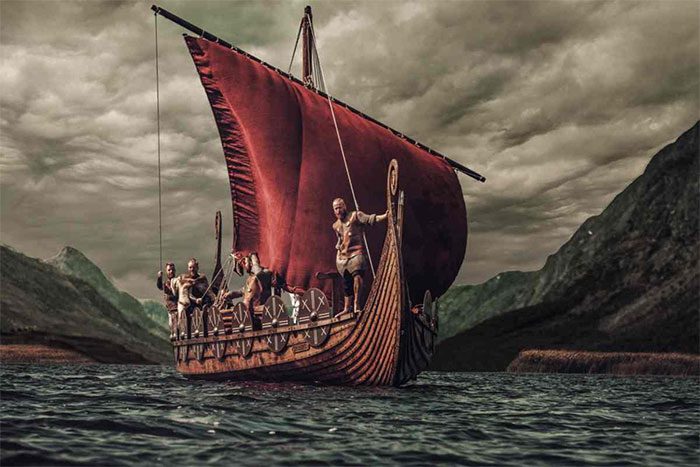In less than 300 years, the Vikings from Scandinavia set foot on at least four continents to conquer and trade with other civilizations. How far did they travel, and what fueled their passion for exploration?
Essentially, the Vikings’ greatest motivation was power and wealth. Medieval archaeology professor Alexandra Sanmark at the University of Highlands and Islands (UK) states:
“The Vikings were well aware of what was happening in England and throughout the British Isles at that time. They knew there were many riches to be gained and had been trading with the locals for a long time. Then one day they realized they didn’t need to trade anymore; they could simply raid.”

A Viking longship cutting through waves, possibly on the way to a new land. (Photo: Corey Ford).
Initially, during the Viking Age (approximately 793 to 1066), they organized armies of young men to sail from Scandinavia during the summer months to conduct raiding campaigns, returning home in the fall.
Over time, they began to settle in new lands, establishing settlements along key conquest routes.
There were periods when the Vikings controlled vast territories, excluding the North Sea Kingdom of Cnut the Great. Archaeologists refer to the Vikings as sea raiders.
Many warlords occasionally collaborated to form powerful armies, or sometimes they conducted separate conquests depending on their perceived interests. There was no sense of national pride here, only personal power and wealth.
The first explorations to the west were raids in northern Scotland, where they quickly took control of the entire population and established Viking-style regulations.
From this foothold, they easily made short sea voyages to the nearby Hebrides and Faroe Islands, eventually reaching Iceland by 870.
Perhaps the most impressive feat was around the year 1000, when they undertook the first trans-Atlantic voyages to southwestern Greenland, and then all the way to Newfoundland in Canada, covering a distance of 3,900 kilometers from their homeland in Norway.
However, despite this achievement affirming the Vikings’ exceptional seafaring skills, evidence also shows that they did not stay long in North America.
Archaeologist Ellen Naess at the Museum of Cultural History in Oslo, Norway, states that we do not know for sure why they stopped living in Newfoundland, but it is a fact that it was too far from home and the resources were quite similar to what they could find back home, so perhaps there was no incentive to explore further.
Nevertheless, the Vikings’ conquests to the east exhibited a distinctly different characteristic.
Leveraging their maritime advantages, Viking warriors traveled through the Baltic Sea and along the inland rivers of Eastern Europe and Russia, passing through present-day Kyiv in Ukraine and Novgorod in Russia in the 900s, and reaching as far as Constantinople in the Byzantine Empire and Baghdad in modern-day Iraq by around the year 1000.
The civilizations here were entirely new to the Vikings, and they must have been amazed to see the buildings, clothing, and artifacts. Here, the Vikings primarily engaged in trade and exchange rather than raiding. They settled in with the locals and became quite powerful.

The civilizations in the east were entirely new to the Vikings. (Illustrative image).
In fact, it is possible that the Vikings traveled even further east than what archaeologists can currently prove.
Professor Sanmark explains: “We can trace them through burial customs, settlement patterns, or sources of materials, and even the items they brought back to Scandinavia. In Sweden, there is Chinese silk, but we cannot confirm how far they traveled to acquire this silk. However, it is clear that they had connections with China and India. There is no doubt about this.”
The southern conquests left a less significant mark. They only navigated around the northern coast of Francia, now known as France, the Iberian Peninsula, which is now Spain and Portugal, and finally along the northern coast of Africa in the early 11th century. However, due to the harsh arid conditions that restricted maritime traffic, they did not attempt to cross the Sahara to venture further into Africa.
The Viking Age gradually came to an end around the mid-11th century with the development of political relations with other cultures and the spread of Christianity that transformed social concepts. Nevertheless, it must be said that in their 300 glorious years, the Vikings left a distinct mark on world history.
Archaeologist Naess assesses that in terms of geographical distance, Newfoundland may be the farthest they ever reached, but in cultural terms, Baghdad represents a greater journey of the Vikings that we may not yet fully understand.


















































